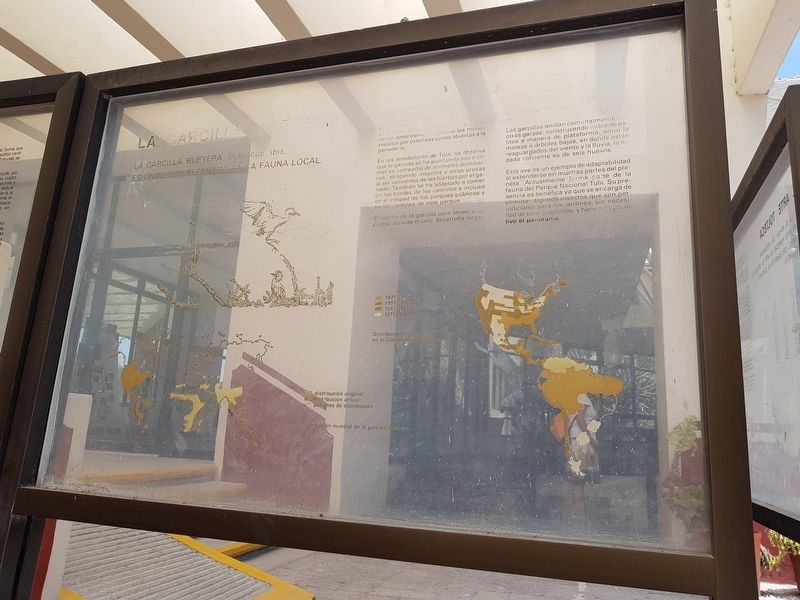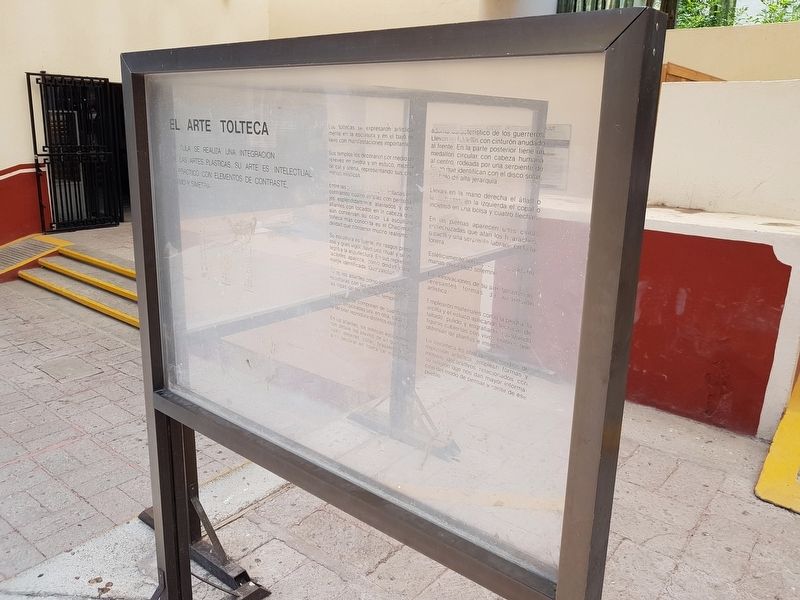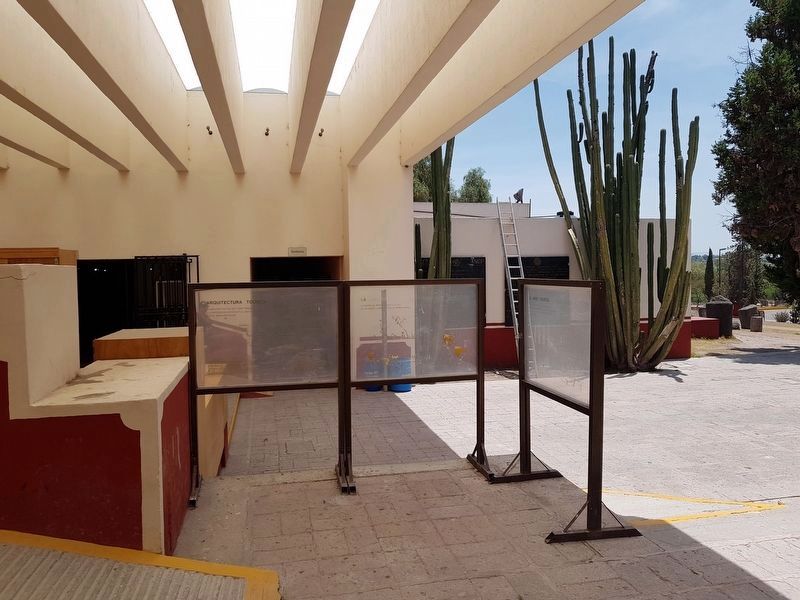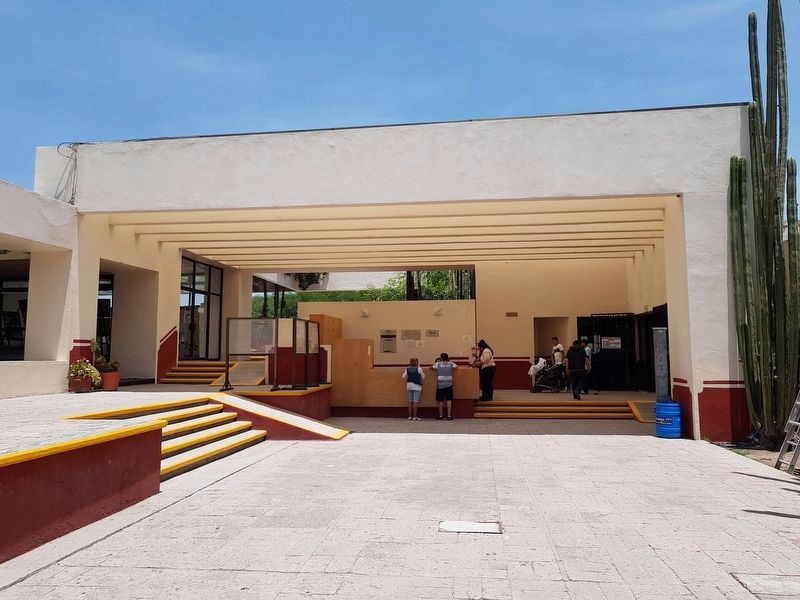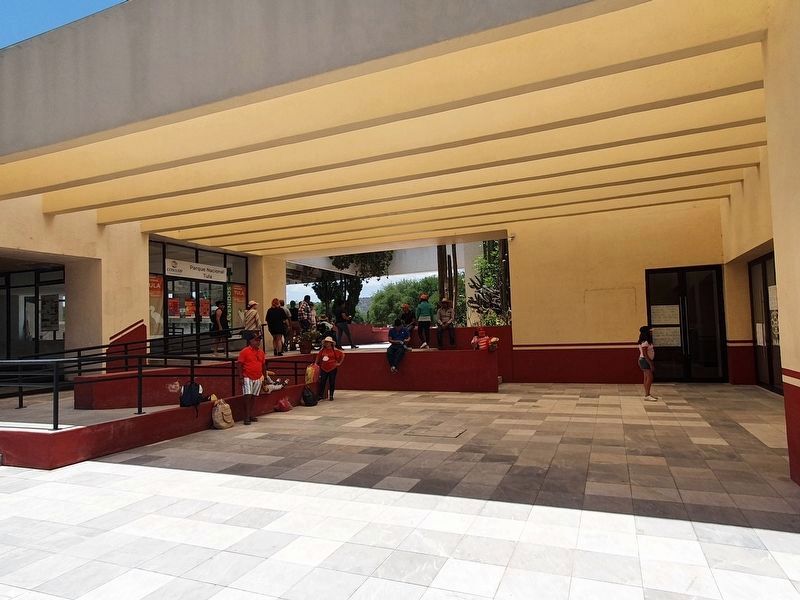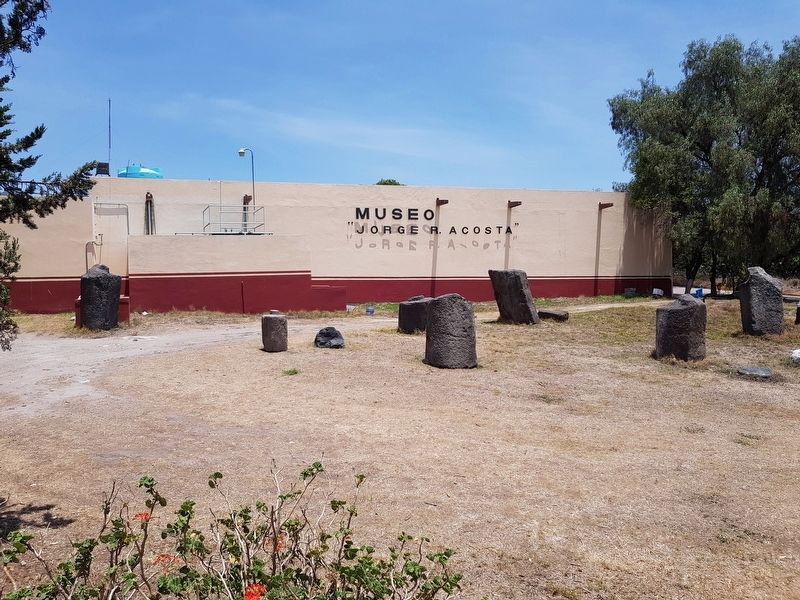Tula de Allende, Hidalgo, Mexico — The Central Highlands (North America)
Toltec Architecture and Art
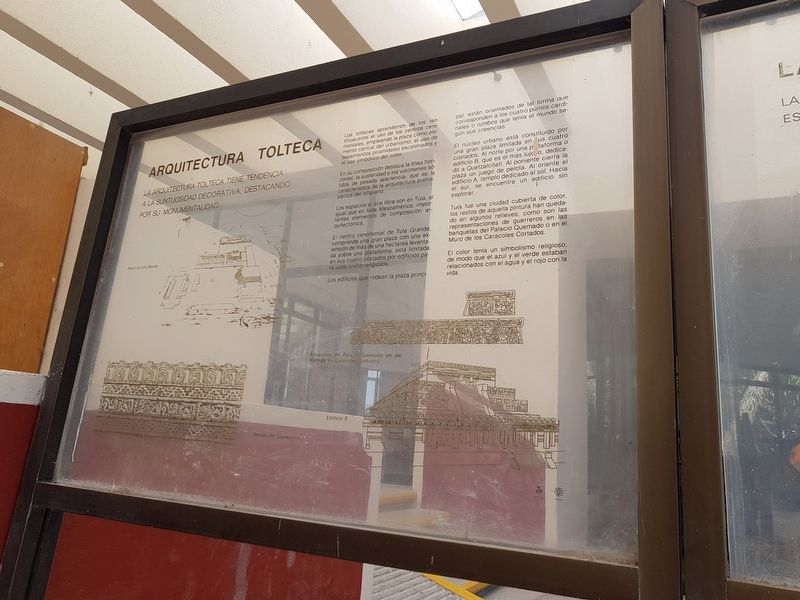
Photographed By J. Makali Bruton, June 2, 2018
1. Toltec Architecture Marker
This set of markers is made up of three panels. The panels were printed on clear plexiglass and they are worn, making them extremely difficult to read in sunlight. The photos of the markers were taken from behind the markers and the images flipped using software.
Arquitectura Tolteca
La arquitectura tolteca tiene tendencia a la suntuosidad decorativa, destacando por su monumentalidad.
Los toltecas aprendieron de los teotihuacanos el uso de los centros ceremonials, empleando la plaza como element central del urbanismo, el uso de basamentos piramidales escalonados y el uso simbólico del color.
En su composición destaca la línea horizontal, la austeridad y los volúmenes sólidos de pesada apariencia, que es la caraterística de la arquitectura prehispánica del altiplano.
Los espacios al aire libre son en Tula, al igual que en toda Mesoamérica, importantes elementos de composición arquitectónica.
El centro ceremonial de Tula Grande, comprende una gran plaza con una extensión de más de una hectárea levatada sobre una plataforma, está limitada en sus cuatro costados por edificios para usos cívico-religiosos.
Los edificios que rodean la plaza principal, están orientados de tal forma que corresponden a los cuatro puntos cardinales o rumbos que tenía el mundo según sus creencias.
El núcleo urbano está constituido por una gran plaza limitada en sus cuatro costados. Al norte por una plataforma o edificio B, que es el más lujoso, dedicado a Quetzalcoátl. Al poniente cierra la plaza un juego de pelota. Al oriente el edificio A, templo dedicado al sol. Hacia el sur, se encuentra un edificio sin explorar.
Tula fue una ciudad cubierta de color, los restos de aquella pintura han quedado en algunos relieves, como con las representaciones de guerreros en las banquetas del Palacio Quemado o en el Muro de los Caracoles Cortados.
El color tenía un simbolismo religioso, de modo que el azul y el verde estaban relacionados con el agua y el rojo con la vida.
Pie de dibujos: Plano de Tula Grande
Banquetas del Palacio Quemado y/o del Muro de los Caracoles Cortados.
Edificio B
Detalle del Coatepantili
La Garcilla Bueyera
La garcilla bueyera Bubulcus ibis, es un nuevo elemento en la fauna local.
…este siglo, la garcilla … al continente americano, ocupando los nichos creados por extensas zonas abiertas a la ganadería.
En los alrededores de Tula, se observa que la garcilla se ha acostumbrado a comer en compañía de animales domésticos, atrapando insectos y otras presas al ser sacudidos de las hierbas por el ganado. También se ha adaptado a comer en los bordes de los caminos e incluso en el césped de los parques públicos y en los jardines de este parque.
El macho de la garcilla para atraer a su pareja durante el celo, desarrolla largas …
Las garcillas anidan comunalmente con otras garzas, construyendo nidos de palitos a manera de plataforma entre la maleza ó árboles bajos, en donde están reguardados del viento y la lluvia, la nidada corriente es de seis huevos.
Esta ave es un ejemplo de adaptabilidad al extenderse en muchas partes del planeta. Actualmente forma parte de la fauna del Parque Nacional Tula. Su presencia es benéfica ya que se encarga de eliminar algunos insectos que son perjudiciales para los jardines, sin necesidad de usar plaguicidas, y hace más atractivo el panorama.
Pie de dibujos: Distribución de la garcilla bueyera en el Continente Americano
Distribución mundial de la garcilla bueyera
El Arte Tolteca
En Tula se realiza una integración de las artes plásticas, su arte es intelectual y prático con elementosde contraste, ritmo y simetría
Los toltecas se expresaron artísticamente en la escultura y en el bajo relieve con manifestaciones importantes. Sus templos los decoraron por medio de relieves en piedra y en estuco, mezcla de cal y arena, representando sus creencias místicas.
Entre las …. Ideales talladas encontramos cuatro estelas con personajes espléndidamente ataviados y dos atlantes con tocados en la cabeza que aún conservan su color. La escultura tolteca más conocida es el Chac-mool deidad que conserva mucho realismo.
Su escultura es fuerte, de rasgo preciosos y gran vigor, tuvo uso ritual y se integró a la arquitectura. En sus representaciones aparece, como deidad claramente identificada, Quetzalcoatl.
Tanto los atlantes como los pilares son esculturas con las cuales se sostenían las vigas del techo de los templos.
Los pilares se componen de cuatro secciones empotradas una en otra, cada cara del pilar reproduce distintos elementos.
En los atlantes, los toltecos esculpieron con detalle los atavio de un guerrero. Lucen orejeras, collar, brazalete y un gran pectoral en forma de mariposa, adorno característico de los guerreros. Llevan un faldellín con cinturón anudado al frente. En la parte posterior tiene un medallón circular con cabeza humana al centro, rodeada por una serpiente de luego que identifican con el disco solar, símbolo de alta jerarquía.
Llevan en la mano derecha el átlatl o lanzadardos, en la izquierda el copal o incienso en una bolsa y cuatro flechas.
En las piernas aparecen unas cintas entrecruzadas que atan los huaraches, o cactli y una serpiente labrada en la talonera.
Estéticamente son representaciones humanas en actitud solemne.
Las innovaciones de su arte generan interesantes formas de expresión artística.
Emplearon materiales como
la piedra, la arcilla y el estuco aplicando técnicas de tallado, pulido y esgrafiado, realizando liguras cubiertas con vivos colores que obtenían de plantas e insectos.
La cerámica es otro de sus medios de expresión artística, emplean formas y motivos decorativos relacionados con su religión que nos dan mayor información del modo de pensar y sentir de ese pueblo.
Pie de dibujos: Atlantes
Chac-mool
Toltec Architecture
Toltec architecture has a tendency to decorative sumptuousness, highlighted by its monumentality.
The Toltecs learned from Teotihuacan the use of ceremonial centers, using the plaza as a central element of urban planning, the use of stepped pyramidal foundations and the symbolic use of color.
In its composition is highlighted the horizontal line, austerity and solid volumes of heavy appearance, which is the characteristic of the pre-Hispanic architecture of the highlands.
The open spaces in Tula, as in all Mesoamerica, are important elements of architectural composition.
The ceremonial center of Tula Grande, comprises a large square with an extension of more than one hectare, built on a platform. It is bound on four sides by buildings for civic-religious purposes.
The buildings that surround the main square are oriented in
such a way that they correspond to the four cardinal points or directions that the world had according to their beliefs.
The urban nucleus is made up of a large square bound on its four sides. To the north is a platform or building B, which is the most luxurious at Tula, dedicated to Quetzalcoatl. To the west is the square a ball court. To the east, the Building A, a temple dedicated to the sun. To the south, there is an unexplored building.
Tula was a city covered in color. The remains of that painting have remained in some reliefs and in the representations of warriors on the benches of the Burnt Palace or the Wall of the Cut Snails (Coatepantli).
Color had a religious symbolism, where blue and green were related to water and red to life.
Captions: Map of Tula Grande
Benches of the Burnt Palace and/or the Wall of the Cut Snails (Coatepantli).
Building B
Detail of the Coatepantli
The Cattle Egret
The Cattle Egret, Bubulcus ibis, is a new element in the local fauna.
... this century, the egret ... to the American continent, occupying the niches created by extensive areas open to livestock.
In the surroundings of Tula, it is observed that the egret has become accustomed to eat in the company of domestic animals, catching insects and other prey when it is
shaken from the grasses by the cattle. It has also adapted to eat on the edges of roads and even on the lawn of public parks and gardens of this park.
The male of the egret attracts its mate during the warm season and develops long ...
The egrets communally nest with other egrets, building nests of sticks into a platform between the brush or low trees, where they are sheltered from wind and rain. A normal clutch is made up of six eggs.
This bird is very adaptable and has spread to many parts of the planet. Currently it is part of the fauna of Tula National Park. Its presence is beneficial as it is responsible for removing some insects that are harmful to the gardens, without the need to use pesticides, and makes the landscape more attractive.
Captions: Distribution of the cattle egret in the American Continent
World distribution of the cattle egret
Toltec Art
The art of Tula shows an integration of the plastic arts. Its art is intellectual and practical with elements of contrast, rhythm and symmetry.
The Toltecs expressed themselves artistically in sculpture and in low reliefs with important manifestations. Their temples were decorated by means of reliefs in stone and stucco, a mixture of lime and sand, representing their mystical beliefs.
Between the ... typical sculpture we find
four steles with splendidly dressed characters and two atlantes with headdresses that still retain their color. The most famous Toltec sculpture is the Chac-mool deity that is very realistic.
The sculpture is strong, with precious traits and great vigor. It had ritual uses and was integrated into the architecture. In its representations it appears as the clearly identified deity of Quetzalcoatl.
Both the atlantes and the pillars are sculptures with which the beams of the roof of the temples were supported.
The pillars are composed of four sections embedded into each other, with each side of the pillar showing different elements.
In the atlantes, the Toltecs carved a warrior's attire in detail. They wear earrings, a necklace, a bracelet and a large butterfly-shaped breastplate, characteristic of warriors. They wear a kilt with a belt tied in front. In the back is a circular medallion with a human head in the center, surrounded by a snake that is identified with the solar disk, a symbol of high status.
They carry in their right hand the átlatl or spearthrower, in the left the copal or incense in a bag and four arrows.
On their legs there are crossed ribbons that tie their huaraches, also known as cactli, and a serpent carved on their heel.
Aesthetically they are human representations with a solemn attitude.
Innovations in their art generated interesting forms of artistic expression.
They used materials like stone, clay and applied stucco, carving, polishing and sgraffito techniques, covering all with bright colors that they obtained from plants and insects.
Ceramics were another of their means of artistic expression, using forms and decorative motifs related to their religion that give us more information about their way of thinking and feeling.
Captions:Atlantes
Chac-mool
Topics. This historical marker is listed in these topic lists: Anthropology & Archaeology • Architecture • Arts, Letters, Music • Environment.
Location. Marker has been reported permanently removed. It was located near 20° 4.034′ N, 99° 20.092′ W. Marker was in Tula de Allende, Hidalgo. Marker could be reached from Calle Tollan just west of Calle Entrada a Zona Arqueológica, on the left when traveling west. The markers are directly to the left of the visitors center of the Tula Archaeological Site. Touch for map. Marker was in this post office area: Tula de Allende HGO 42800, Mexico.
We have been informed that this sign or monument is no longer there and will not be replaced. This page is an archival view of what was.
Other nearby markers. At least 8 other markers are within walking distance of this location. Tula (approx. 0.6 kilometers away); Ball Court 1 (approx. 0.6 kilometers away); El Coatepantli (Wall of Snakes) (approx. 0.7 kilometers away); The Temple of Pyramid B (approx. 0.7 kilometers away); Pyramid B (approx. 0.7 kilometers away); Pyramid C and the Adoratory (approx. 0.7 kilometers away); The Burnt Palace (approx. 0.7 kilometers away); The Wall of Skulls (approx. 0.8 kilometers away). Touch for a list and map of all markers in Tula de Allende.
Credits. This page was last revised on May 27, 2022. It was originally submitted on June 17, 2018, by J. Makali Bruton of Accra, Ghana. This page has been viewed 260 times since then and 20 times this year. Photos: 1, 2, 3, 4, 5. submitted on June 17, 2018, by J. Makali Bruton of Accra, Ghana. 6. submitted on May 27, 2022, by J. Makali Bruton of Accra, Ghana. 7. submitted on June 17, 2018, by J. Makali Bruton of Accra, Ghana.
